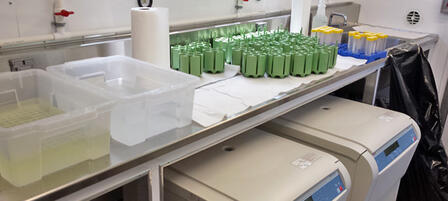Fishing Regulation Changes Slow the Spread of Asian Carp

PRATT – Many anglers remember when the Kansas Department of Wildlife, Parks and Tourism (KDWPT) changed bait regulations in 2012 to limit the use of wild-caught bait to within the drainage where collected as well as the 2013 amendment to lessen restrictions for bluegill and green sunfish. The intent of these regulations was to prevent the spread of aquatic nuisance species such as Asian carp, white perch, and zebra mussels. Sampling conducted earlier this year appears to show that anglers adhering to the bait regulations helped slow the spread of Asian carp through Kansas waters.
In July 2015, KDWPT partnered with the U.S. Fish and Wildlife Service (USFWS) to sample 11 locations from six river basins throughout Kansas to detect the presence of environmental DNA (eDNA) left behind by bighead and silver carp (collectively known as Asian carp). Over a three-day span, two field crews, each comprised of two KDWPT Aquatic Nuisance Species (ANS) program staff and one USFWS staff, collected 204 eDNA samples. An additional USFWS crew, manning a portable trailer with cooled centrifuges, prepared the samples for shipment to and processing by the USFWS Whitney Genetics Lab in LaCrosse, Wis.
Results were released to KDWPT earlier this month and are available at http://www.fws.gov/midwest/fisheries/eDNA.html, but to summarize, none of the samples collected contained Asian carp eDNA. ANS program coordinator Jessica Howell has a good guess as to why.
“We believe the bait regulations have had a positive impact on protecting our natural resources from ANS such as Asian carp, as evidenced by the apparent lack of spread of bighead and silver carp throughout the state,” said Howell. She went on to add that locations such as Atchison State Fishing Lake and the Kansas River above the Bowersock Dam in Lawrence are areas we would have expected to see positive samples if the fish were moved upstream. Instead, these popular fishing locations were negative for eDNA, despite downstream populations where reproduction by the fish has been documented.
Regulations were changed because ANS, including Asian carp and white perch, can easily be confused with similar-looking native species by anglers catching bait. Small bighead and silver carp look very similar to native gizzard shad. White perch look very similar to native white bass. When the KDWPT Commission amended the regulations in 2013 to allow bluegill and green sunfish to be moved, part of the decision was that bluegill and green sunfish do not look like invasive fish currently in Kansas (bighead carp, silver carp, and white perch).
Anglers and boaters should be aware of Kansas regulations enacted to prevent the spread of aquatic nuisance species, including:
- Wild-caught bait must be used in the common drainage where collected and may not be moved upstream of a dam or natural fish barrier. Bluegill and green sunfish collected from non-designated aquatic nuisance waters may be possessed as live bait anywhere in the state.
- No live fish may be taken from designated aquatic nuisance waters, including sport, non-sport, and baitfish.
- Anglers fishing with bait purchased from a commercial dealer must have the receipt in their possession while fishing with purchased bait.
- Boaters must pull drain plugs and drain livewells and bilges before transporting their boat on public highways.
- It is illegal to possess certain species or to release wildlife on department lands or waters, federal reservoirs, and navigable publicly owned rivers.
KDWPT recommends that all water users Clean, Drain, and Dry all equipment after each use to prevent the spread of aquatic nuisance species.
- Clean – Remove all plants, animals and mud; thoroughly wash everything, especially crevices and hidden areas.
- Drain – Eliminate all water before leaving the area, including livewells, ballast and engine cooling water. Dispose of unused bait on land or in an approved bait receptacle.
- Dry – Allow five days for your equipment to completely dry before transporting to other waters. If you cannot wait five days, clean your boat with high-pressure hot water (140 degrees for 10 seconds of contact).
For more information on eDNA sampling efforts, and how you can help play a part in the fight against ANS, visit www.protectKSwaters.org or contact Howell at Jessica.howell@ksoutdoors.com.
-30-







